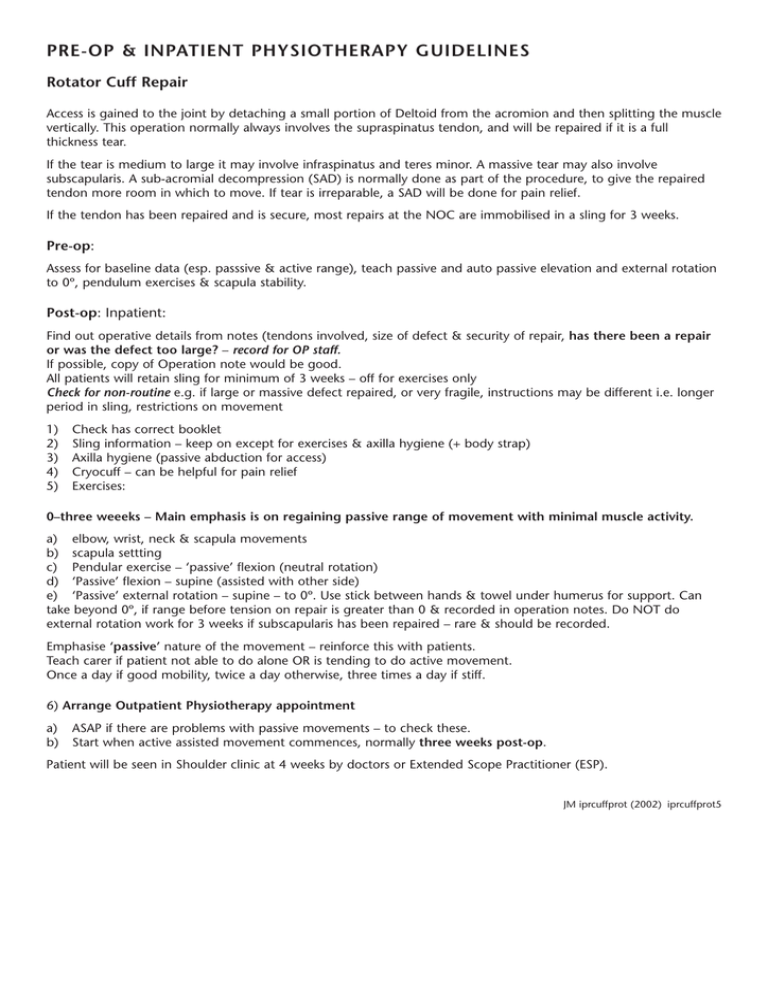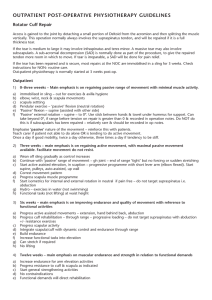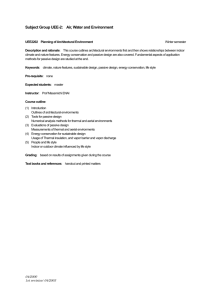PRE-OP & INPATIENT PHYSIOTHERAPY GUIDELINES Rotator Cuff Repair
advertisement

PRE-OP & INPATIENT PHYSIOTHERAPY GUIDELINES Rotator Cuff Repair Access is gained to the joint by detaching a small portion of Deltoid from the acromion and then splitting the muscle vertically. This operation normally always involves the supraspinatus tendon, and will be repaired if it is a full thickness tear. If the tear is medium to large it may involve infraspinatus and teres minor. A massive tear may also involve subscapularis. A sub-acromial decompression (SAD) is normally done as part of the procedure, to give the repaired tendon more room in which to move. If tear is irreparable, a SAD will be done for pain relief. If the tendon has been repaired and is secure, most repairs at the NOC are immobilised in a sling for 3 weeks. Pre-op: Assess for baseline data (esp. passsive & active range), teach passive and auto passive elevation and external rotation to 0º, pendulum exercises & scapula stability. Post-op: Inpatient: Find out operative details from notes (tendons involved, size of defect & security of repair, has there been a repair or was the defect too large? – record for OP staff. If possible, copy of Operation note would be good. All patients will retain sling for minimum of 3 weeks – off for exercises only Check for non-routine e.g. if large or massive defect repaired, or very fragile, instructions may be different i.e. longer period in sling, restrictions on movement 1) 2) 3) 4) 5) Check has correct booklet Sling information – keep on except for exercises & axilla hygiene (+ body strap) Axilla hygiene (passive abduction for access) Cryocuff – can be helpful for pain relief Exercises: 0–three weeeks – Main emphasis is on regaining passive range of movement with minimal muscle activity. a) elbow, wrist, neck & scapula movements b) scapula settting c) Pendular exercise – ‘passive’ flexion (neutral rotation) d) ‘Passive’ flexion – supine (assisted with other side) e) ‘Passive’ external rotation – supine – to 0º. Use stick between hands & towel under humerus for support. Can take beyond 0º, if range before tension on repair is greater than 0 & recorded in operation notes. Do NOT do external rotation work for 3 weeks if subscapularis has been repaired – rare & should be recorded. Emphasise ‘passive’ nature of the movement – reinforce this with patients. Teach carer if patient not able to do alone OR is tending to do active movement. Once a day if good mobility, twice a day otherwise, three times a day if stiff. 6) Arrange Outpatient Physiotherapy appointment a) b) ASAP if there are problems with passive movements – to check these. Start when active assisted movement commences, normally three weeks post-op. Patient will be seen in Shoulder clinic at 4 weeks by doctors or Extended Scope Practitioner (ESP). JM iprcuffprot (2002) iprcuffprot5




